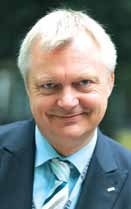How information is turned into knowledge
If you look at the current – not to mention the future – challenges in the hospital environment the term information technology seems misleading. Surely there is no dearth of information. The foremost task of technology however is to turn information into knowledge. EH@Medica talked to Bernhard Calmer, Head of IT Sales, Siemens Healthcare, Germany, about the new knowledge technology and its applications.

Mr Calmer, let’s have a look at the operating theatre: What will IT have to offer in order to turn complex data into knowledge?
Since the OT has long been well integrated into the hospital IT and the HIS we are already in the process of fine-tuning applications. The OT is one of the most complex areas in a hospital which on top requires enormous personnel, material and equipment resources. Therefore we are seeing a major demand for cost containing software solutions that are also deeply integrated into the hospital IT. The buzz words are process optimization and improved usability. Process optimization includes aspects such as better pre-op planning but also real-time adjustments during the intervention. The moment the surgeon realizes that the intervention will take longer than planned this information is processed and transmitted to the ward where the next patient is being prepared for surgery. This is by no means as trivial as it sounds.
And it takes us to the second major aspect: usability, meaning the application of IT solutions in the OT. How is the surgeon supposed to operate IT hardware when his hands are deep down in the patient, his feet control several devices and with his speech he controls the OT team? One idea is to use game console technology where a camera records movements which in turn trigger actions. The aim is to develop IT that can be operated more intuitively and with simple movements to make information available quicker and more easily. These are the issues that I think developers of hospital IT for the OT will have to solve.
Where and in which systems should all these data come together? And what will the future relationship between HIS and PACS be?
I think that we will continue to have process control systems and archiving systems side by side. As far as archiving is concerned the PACS will surely take on more functions and become an overall archive for all kinds of images, documents and films. The current digital library is still based on the logic behind the old paper archiving system where the x-ray images were kept separately since they did not fit in an A4 box. That is entirely obsolete today and the trend will be towards storing and archiving all patient-relevant data in a single system.
Everybody wants all patient data to be collected and made available on-screen by a mouse click. Which efforts are being made to match and integrate the wide variety of data?
To display data on a screen simply means that they are presented synchronously and in a structured manner. And this is exactly what many providers of IT solutions are currently working on. It does not mean that all data are stored in one system. If you ask me that wouldn’t make sense. The PACS for exactly is designed to manage and process images. Why would you want to remove these data from this system? The same holds true for the HIS which was designed to collect, document and manage data. Why should these functions be integrated into other programmes?
What’s crucial is interoperability of the systems by different vendors – this is also a task that has to be tackled in the future. But we have to accept the fact that nobody can do this alone. Not even Siemens. We cooperate with partners whose solutions can be integrated in our systems and we take care of the interfaces.
Interoperability goes far beyond the hospital. Take “personalized medicine” for example – it will increase the number of data sources. In complex cases the data from the general practitioner, the hospital, the lab, radiation therapy, etc. will have to be managed centrally in order to provide access to the patient data anytime and from anywhere. But who and where is this central location going to be? This is a question which needs to be thought through carefully. Maybe the central administration of a hospital would be a good place to collect the data. The hospital in cooperation with a partner could offer this as a service to other clinics, healthcare institutions or doctor’s offices.
Will we at all be able to manage the future data flood?
The writer John Naisbitt put it succinctly: “We are drowning in information but we are starving for knowledge.” We don’t have a problem with the volume of information but with the identification of relevant information. This situation creates a wealth of opportunity for companies to offer data mining services or develop search machines for clinical data. There are preliminary approaches in imaging called computer-aided diagnostic. We don’t think that software can provide a diagnosis. But we are convinced that in the future the data that are relevant for the diagnosis cannot be analyzed and made available without the help of software. This is one of the major challenges we are facing and we are investing significant resources in mastering it.
Thank you very much for this interview.
17.11.2011











